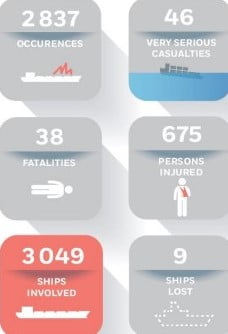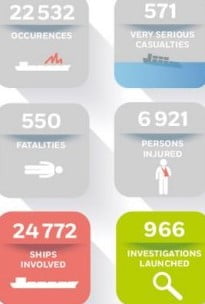EMSA published its Annual Overview of Marine Casualties and Incidents consisting of analysis of marine casualties or incidents accidents reported until 31 December 2020 by the EU Member States in the European electronic database (EMCIP).
The year 2020 appeared to have been a positive year considering the decrease or stabilisation of most of the indicators, such as the number of occurrences, ships lost, fatalities or injuries.
However, consequences of COVID pandemic are very likely to have affected the area of marine casualties and incidents, taking into consideration its significant impact on shipping in 2020:reduced traffic in general, cruise ships and ferries activities heavily disrupted, etc.
In order to draw objective comparisons between the different types of ship, ratios between the number of occurrences involving each type of ship and its corresponding fleet size over 2014- 2020 were calculated. Due to data unavailability regarding non-EU flag ships, calculations were limited to ships carrying an EU Flag, and with an IMO number when it related to cargo ships, passenger ships and service ships.
The report notes that the overall average occurrence indicator was 1812, while it was reported that it reduced from 216 in 2015 to 131 in 2020, meaning a reduction of 39.4%.
At ship categories level, both passenger ships and cargo ships had their average indicators above the average, namely 350 and 214.
However, a continuous decrease of annual indicators was observed since 2015 for both ship types:
- From 432 to 167 for passenger ships;
- From 294 to 158 in 2020.
…while the average indicator for all ships in 2020 is 131.
Regarding service ships, this category had the lowest indicator, with an average of 77 over the period 2014-2020 and a total of 64 in 2020.
Finally, the occurrence indicator about fishing vessels was 84 over the period. However, it was noted that it continuously increased from 2014 (58) to 2020 (137) and therefore, safety level related to fishing vessels has negatively evolved during the past years.
A similar evolution regarding the number of ships lost was noted: after an increase of up to 35 in 2018, a decrease in 2019 was recorded, with 22 ships lost. Only 9 losses of ships were recorded in 2020.
During the 2014-2020 period, 367 casualties resulted in a total of 550 lives lost. After a continuous important decrease until 2017 when 46 fatalities were recorded, an increase up to 72 was recorded in 2019.
In 2020, 38 fatalities were recorded. 89.1% of the victims were crew members. The main event resulting in fatalities was collision, when it related to a ship, and slipping / falls when it related to a person.
Over the period 2014-2020, 6921 injuries were recorded, corresponding to 6211 occurrences.
Again, crew members represent the main category of persons injured at sea with 81% of the victims
said EMSA.
In 2020, apart from the fishing vessels, the number of all other types of ships involved in casualties and incidents indicated a reduction. Excluding individual variations, such as passenger ships in 2019 or service ships in 2018, such general descending trends were noted over the period 2014-2020, except for fishing vessels where an overall increase was noted.
In 2020, 1386 cargo ships were involved in marine casualties or incidents resulting in 21 fatalities. It should be noticed that only one cargo ship was lost.

With a total of 106, fishing vessels remain the category of ships with the highest number of ships lost over 2014-2020. Namely, in 2020, the number of occurrences involving fishing vessels continued increasing; however, the number of ships lost reduced to six (in comparison with 15 in 2019) and the number of injuries remained stable, around 220.
What is more, almost half of the casualties that took place on board a passenger ship involved a ro-ro passenger ship, also known as “ferries”. No passenger ship was lost in 2020; the number of fatalities and injuries has continued its decreasing trend.
In 2020, one service ship was lost. The number of service ships involved in a casualty continued decreasing, as well as the number of fatalities and injured persons.
In 2020, 90 ships of other types were involved in marine casualties and incidents, mainly recreational motorboats and sailing boats. One ship was lost, and three fatalities were reported.
Over the period 2014-2020, accidents of navigational nature, (collisions, contacts and groundings/strandings) represented 43% of all occurrences related to the ship. It was however noted that the main type of accident to a ship was the loss of propulsion power, that counted for 22%, meaning an average of 503 losses of propulsion per year.
Regarding occurrences to person(s), 36% were attributed to slipping, stumbling and falling of persons. Among the falls, 9.8% were fall overboard.

Moreover, from 2014 to 2020, the departure phase appeared to be the safest segment of a voyage (9% of the occurrences) and the en route portion the most unsafe (43%). It was noted that half of the casualties occurred in internal waters, more precisely in port areas (41%).
EU Member States investigation bodies have launched 966 investigations over the 2014-2020 period and 823 safety investigation reports were made public. In 2020, 84 investigations were reported to have been launched, meaning a decrease of about 30% in comparison with the year 2019.
From analysis conducted during safety investigations, it was determined that, from 2014 to 2020, either at accident event or contributing factor levels, 89.5% of all occurrences were related to human action.
Over the period 2014-2020, almost 3000 actions were taken or safety recommendations issued. 45% were related to ship procedures, in particular when dealing with operation of ships.































































